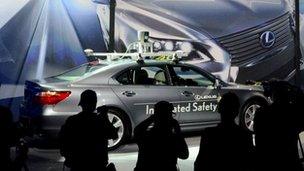Spanish scientists develop more accurate sat-nav system
- Published

Researchers in Spain have developed a system they say can greatly improve the accuracy of car sat-navs.
It combines a conventional global positioning system (GPS) signal with those of other sensors - accelerometers and gyroscopes - to pinpoint a car's location to within 2m (6ft 6in).
It can be cheaply installed in any car and may eventually work on smartphones, the researchers say.
Such a system has the potential to help the burgeoning driverless car industry.
The system was jointly designed and developed by the Applied Artificial Intelligence Group and the Systems Intelligence Laboratory - both based at Carlos III University in Madrid (UC3M).
"We have managed to improve the determination of a vehicle's position in critical cases by between 50 and 90%," said researcher David Martin.
According to the scientists, the margin of error of commercial GPS used in cars is about 15m in an open field, where the receiver has good visibility from the satellites.
However, in cities where the signal bounces off buildings and trees, the calculation of a vehicle's position can be off by more than 50m.
In certain cases, such as in tunnels, communication is lost completely.
At that point, the system reverts to essentially guessing the location. While this may be sufficient for in-car navigation systems, it would not be suitable for automated vehicles, which are currently being developed by the likes of Google.
"Cars are becoming increasingly connected," said Prof David Bailey from the Coventry University Business school.
"There is a lot of research into driverless cars and, for that, GPS needs to be as accurate as possible," he added.
The system developed in Madrid makes use of a unit comprised of three accelerometers and three gyroscopes, which keep track of the speed and direction of a vehicle at all times.
The data from these is combined with that from a conventional GPS unit to pinpoint a location of a car to within 2m in cities.
Using smartphones
The next step for the Spanish researchers is to develop a system that can work with smartphones.
Most are equipped with a range of sensors, including an accelerometer, a gyroscope, a magnetometer, GPS and cameras, in addition to wi-fi, Bluetooth and GSM communications.
"We are now starting to work on the integration of this data fusion system into a mobile telephone," said researcher Enrique Marti.
"It can integrate all of the measurements that come from its sensors in order to obtain the same result that we have now, but at an even much lower cost, since it is something that almost everyone can carry around in their pocket."
- Published30 January 2013
- Published10 December 2012
- Published4 October 2012